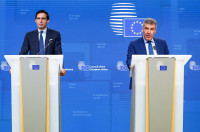Climate & Environment
Everything you need to know about Nepal’s carbon trade deal
Nepal will receive $5 for every tonne of carbon dioxide emission reduced as country embarks on earning up to Rs5 billion by selling 9 million tonnes of CO2 by 2025.
Chandan Kumar Mandal
On Thursday, the government signed a multi-million dollar agreement with the World Bank’s Forest Carbon Partnership Facility (FCPF), a global partnership of governments, business organisations, civil society, and indigenous groups’ organisation for reducing emissions by protecting forests.
Under the scheme, Nepal can potentially access up to US$45 million (approximately Rs5 billion) by 2025 to mitigate its emissions by implementing activities as per the UN mechanism called ‘Reducing Emissions through Deforestation and Degradation’ (REDD).
Here is everything you need to know about the latest agreement and its significance:
Why was Nepal selected for reducing its emission levels?
As a least developed country, Nepal is eligible to sell carbon to developed countries that want to offset their emissions under the Reducing Emissions through Deforestation and Degradation (REDD) programme.
For reducing emissions, countries implement a collection of actions (commonly referred to as REDD+).
The REDD+ is a framework created by the UN Framework Convention on Climate Change’s Conference of the Parties (COP) to guide activities in the forest sector to reduce emissions from deforestation and forest degradation, and to enhance forest carbon stock, adopt sustainable land use management in developing countries.
In exchange for their contribution to bringing down emissions, countries such as Nepal are given a certain amount of money.
“Nepal’s Emission Reductions Program builds on more than three decades of successful community forestry,” said Fris Hadad-Zervos, the World Bank’s Nepal Country Director. “The emissions reduction purchase is one pillar of a strategic program on forest landscapes and climate action in Nepal. This innovative financing agreement will address the drivers of deforestation and forest degradation, helping incentivise further community action across the country.”
Nepal had submitted a proposal for its project, ‘People and Forests: A Sustainable Forest Management-Based Emission Reduction Program in the Terai Arc Landscape, Nepal’ to the Forest Carbon Partnership Facility (FCPF) Carbon Fund in 2018.
Why does it matter?
Nepal is the fifth country in the Asia-Pacific and 12th in the world to sign such a milestone agreement with the FCPF. The agreement has been touted as a landmark achievement for the country as this would be the first financial support for Nepal for keeping its emissions low.
“This scale of results-based payments for emission reductions is a first for Nepal,” said Finance Secretary Sishir Kumar Dhungana.
Nepal, home to 6.61 million hectares of forests and other wooded lands (44.74 percent of the total area), has the potential to generate revenue from carbon financing by participating in the REDD+ programme. Nepal has been working for several years to become eligible for carbon trading or generate revenue by selling carbon stored in its forests.
“Nepal had been working on it for at least ten years as part of the preparation for carbon trading. The signing of the agreement is a landmark event in our pursuit of carbon trade, a significant achievement,” said Buddi Sagar Poudel, chief of the REDD Implementation Centre under the Ministry of Forests and Environment. “A lot of work has happened in the last ten year; therefore, we could reach this level and make our claims for carbon trade.”
What are the works Nepal has done to be eligible for carbon trading?
According to Poudel, preparations have been made mainly in four sectors. First, the government prepared a REDD+ Strategy in 2018 to guide the development of a set of policies and programmes that address the drivers of deforestation and forest degradation. For the implementation of the REDD+ Strategy, various 75 activities were outlined.
The government also developed the Emission Reduction Program Document (ERPD), a 253-page proposal, which will be a guiding document for implementing activities under the new agreement. It also prepared the Safeguards Information System for meeting social and environmental safeguards for promoting gender and indigenous issues as well as preserving indigenous knowledge while implementing the REDD, among others. The government also completed the national forest reference emissions level and measurement, reporting, and verification of carbon stocked in its forests.
How will Nepal reduce emissions to access benefits as per the carbon trade agreement?
The government will implement various activities at a sub-national scale in 13 districts of the TeraiArc Landscape (TAL), west of the Bagmati.
“Forests in the Terai region provide ecosystem services that are critical for climate resilience, including watershed protection, and drought and flood mitigation,” said Bishwa Nath Oli, Secretary at the Ministry of Forests and Environment. “This programme will help protect forests that are inextricably linked to the well-being of many communities here and across the country.”
For accessing revenues, Nepal needs to either cut down emissions or increase carbon stock in the forest.
“We have two ways to reduce carbon-dioxide levels. Either we control activities that increase the emission of gases or speed up carbon sequestration, the process of removing carbon dioxide from the atmosphere and capturing it elsewhere, for example, forests,” said Poudel. “Only then can we get the revenue for reducing carbon-dioxide emissions. Carbon trade is not alike giving or receiving money for selling any commodity, but it’s about incentivising our efforts to reduce carbon-dioxide emissions.”
For estimating the national forest reference emission level, a baseline study was conducted to measure the carbon-dioxide emissions from forests in the country. According to Poudel, the net carbon-dioxide emission of the country was 1.2 million tonnes every year.
“We can either control emissions through afforestation or by controlling deforestation and degradation of forest areas,” said Poudel. “Therefore, as per the existing mechanism, we would get revenue from emission reduction from activities like not letting wildfire incidents occur or increasing carbon stock by increasing forest cover or improving our degraded forests. Both ways work.”
What are the targets under the new agreement?
With this Emission Reductions Payment Agreement (ERPA) in place, Nepal is expected to reduce 9 million tons of carbon dioxide emissions in the Terai Arc Landscape. For each tonne of carbon-dioxide emission reduced, Nepal will receive $5 in return.
According to estimates, forest cover in 13 districts can reduce 34 million tonnes of carbon-dioxide between 2018-2028. Out of which, 23 percent (7.9 million tonnes) can not be sold as they are kept as a buffer.
“In case there is a forest fire, then we may end up releasing more carbon dioxide as well as losing the stocked carbon,” said Poudel. “Therefore, we can not commit to selling all the carbon.”
Of the remaining 26 million tonnes, which is estimated to be reduced between the 2018-2028 period, only 10 million tonnes are likely to be available between 2018-2025 when the agreement ends. Hence, the government has signed the agreement to only trade 9 million tonnes of carbon-dioxide for now.
How does Nepal plan to achieve the target?
For achieving the targets, Nepal has outlined seven activities. The country will work towards improving management practices in existing community-based forest management. Likewise, officials plan to transfer national forests to communities that can work on restoring them. It shall also support and promote private sector forests. According to Poudel, nearly 30,000 hectares of private forests exist in 13 districts. The government also aims to encourage the use of alternative energy resources as well as work on leasehold forests. Likewise, it plans to improve integrated land use planning to reduce forest conversion for infrastructure development and promote better management of existing protected areas in the country.
“The government will also work towards minimising haphazard development which ends up adversely impacting forests,” said Poudel. “Also, we can’t forget the protected areas. The government can not only focus on protecting forests outside while protected parks experience degradation of forests.”
When and how the carbon stock will be measured?
For receiving the revenue from carbon financing, the stock of carbon will be measured twice—once in 2021 and then in 2025, the final year of the agreement—for determining how Nepal has reduced its carbon-dioxide emissions through the REDD programme.
According to Poudel, the carbon absorbed in the forests does not equal carbon-dioxide emissions, as a ton of carbon can produce 3.67 tonnes of carbon dioxide.
“We have sold one tonne of carbon dioxide, not carbon, at $5,” said Poudel.
Will Nepal get all the $45 million revenue by 2025?
Although the government and the World Bank have signed the agreement unlocking the potential to get $45 million in revenue from carbon trade, the country may not get the whole amount. The amount quoted is maximum Nepal can receive under the programme.
“This is completely a result-based trade and depends upon how much we can deliver,” said Poudel. “For example, one is paid as much as they produce. But with business as usual, it will be difficult to secure the entire funds.”
What will happen to the rest of the carbon stored then?
The World Bank’s Forest Carbon Partnership Facility (FCPF), launched in 2008, has worked with 47 developing countries across Africa, Asia, and Latin America, and the Caribbean, along with 17 donors that have made contributions and commitments totalling US$1.3 billion. But this setup will be phased out in 2025. Then, countries like Nepal will have to find another buyer for their stock of carbon.
“Either we have to find new buyers to sell our carbon absorbed through REDD or wait for the same mechanism to continue so that we can again trade with the World Bank’s Forest Carbon Partnership Facility (FCPF),” said Poudel.




 7.98°C Kathmandu
7.98°C Kathmandu










